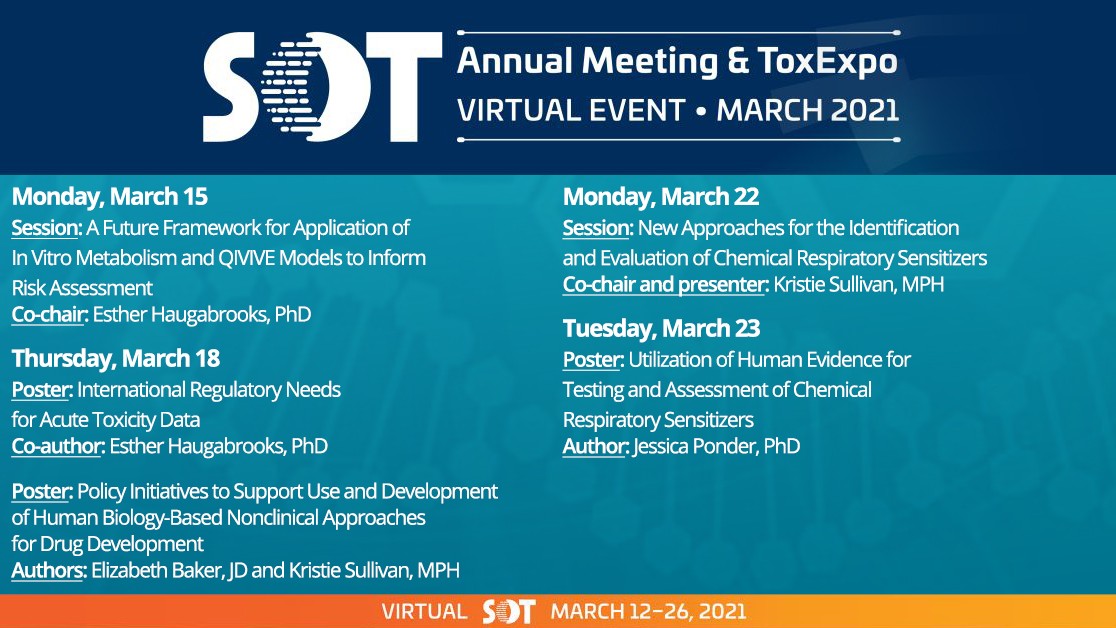Physicians Committee Scientists to Present at 2021 Society of Toxicology Meeting

Physicians committee scientists and policy experts will have a lot to contribute at this year’s virtual Society of Toxicology meeting. Members of our team will join other researchers, academics, and representatives from industry to present on pressing matters in the field—making sure that nonanimal test methods are front and center—at the largest annual gathering of toxicologists anywhere.
A Future Framework for Application of In Vitro Metabolism and QIVIVE Models to Inform Risk Assessment
Monday, March 15, 11:15 a.m. – 2:00 p.m. ET
Chairs:
Esther Haugabrooks, Physicians Committee for Responsible Medicine
Kelly Magurany, NSF International
Presenters:
Sandra Coecke, European Commission Joint Research Centre
Xiaoqing Chang, Integrated Laboratory Systems Inc.
Kelly Magurany, NSF International
Sue Marty, Dow
Rebecca Clewell, 21st Century Tox Consulting
Recent advancements of in vitro methodologies provide valuable insight into better ways to incorporate toxicokinetics and exposure in various decision-making contexts. One of the indisputable benefits of in vitro approaches is their capacity to increase chemical throughput compared with animal testing, allowing faster chemical screening and prioritization. However, with the advent of pressing global drivers to reduce and eliminate animal testing, understanding the utility of integrated in vitro approaches is critical. Often in chemical safety testing, when evaluating or extrapolating human kinetics from in vivo models, providing a comparison of effect levels from exposure scenarios has been challenging. Increasing evidence demonstrates we can move beyond the use of in vitro assays for compound prioritization and risk ranking potential to applications for quantitative exposure and risk estimates by using physiologically based pharmacokinetic (PBPK) models and quantitative in vitro to in vivo extrapolation (QIVIVE). The advantage of using in vitro approaches now extends to dose-response relationships, benchmark dose modeling, and elucidating complex metabolic pathways. By leveraging an understanding of toxicokinetics and dose-response relationships, QIVIVE converts in vitro bioactivity through reverse dosimetry to estimate human equivalent administered dose. The objective of this session is to demonstrate, through the use of integrated approaches, the application of in vitro metabolism and QIVIVE in various decision-making contexts. Key discussion points will include interpreting integrated data streams, building confidence in new approaches to inform quantitative risk assessment, applying weight of evidence to overcome assay uncertainty, and increasing uptake of new methodologies for regulatory application. Based on current findings, this session also will outline an initial framework to learn how in vitro technologies can be used to increase confidence in chemical safety and inform risk assessment. The session begins with a brief review of recent technological advances. Each speaker will then present a novel case study illustrating the benefits and complexities of adopting in vitro metabolism and QIVIVE models for chemical risk assessment.
International Regulatory Needs for Acute Toxicity Data
Thursday, March 18, 1:00 p.m. – 2:45 p.m. ET
J. Strickland1 , A. B. Daniel1, D. G. Allen1, N. C. Kleinstreuer2, and E. Haugabrooks3. 1Integrated Laboratory Systems Inc., Research Triangle Park, NC; 2NIEHS/NICEATM, Research Triangle Park, NC; and 3Physicians Committee for Responsible Medicine, Washington, DC.
Chemical regulatory authorities around the world consider acute systemic toxicity data to substantiate safety assessments, and for many regulations these data are required. Acute oral, dermal, and inhalation data are typically used to develop product hazard labels for consumer or worker protection and to assess risks from acute exposure to chemicals. Other uses include setting occupational exposure levels, dose-setting for longer term studies, and classifying mechanism of action. To identify opportunities for regulatory uses of nonanimal replacements for acute systemic toxicity tests, we reviewed acute systemic toxicity testing requirements for Brazil, China, Canada, Japan, the European Union, South Korea, and the United States, which participate in the International Cooperation on Alternative Test Methods (ICATM). Our chemical sectors of interest for each jurisdiction were cosmetics and personal care products, consumer products, industrial chemicals, pharmaceuticals, medical devices, and pesticides. We found acute systemic toxicity data were most often required for hazard identification rather than risk assessment. Where animal methods were required, animal reduction methods were typically recommended. However, for many jurisdictions and chemical sectors, non-animal alternatives were not accepted. The most frequently acceptable nonanimal approaches were test waivers. For example, guidance on medical device testing from the International Standards Organization and for pharmaceuticals from the International Conference on Harmonization both indicate that acute toxicity information can potentially be obtained from other studies. An understanding of international regulatory requirements for acute systemic toxicity testing will inform the development of ICATM’s strategy for the development, acceptance, and implementation of nonanimal alternatives to assess the health hazards and risks associated with acute toxicity. This project was funded by the Physicians Committee for Responsible Medicine and with federal funds from the NIEHS, NIH under Contract No. HHSN273201500010C.
Policy Initiatives to Support Use and Development of Human Biology-Based Nonclinical Approaches for Drug Development
Elizabeth Baker and Kristie Sullivan, Physicians Committee for Responsible Medicine
A shift is underway in toxicology. Private and publicly funded scientists are developing new approaches that are expected to better protect public health and be more predictive for humans than traditional animal-based methods because they integrate human cells, tissues, and biological process. Stakeholders are collaborating on projects that aim to evaluate and integrate these new approaches into product testing. Policy change that provides regulatory certainty is crucial because animal studies are otherwise ingrained in regulatory policy and industry practice. The Food and Drug Administration has already taken steps to address this via its Innovative Science and Technology Approaches for New Drugs (ISTAND) program.
New Approaches for the Identification and Evaluation of Chemical Respiratory Sensitizers
Monday, March 22, 11:15 a.m. – 2:00 p.m.
Chairs:
Kristie Sullivan, Physicians Committee for Responsible Medicine
Shannon Krieger, Dow Chemical
Speakers:
Shannon Krieger, Dow Chemical
Keith Salazer, US Environmental Protection Agency
Arno Gutleb, Luxembourg Institute for Science and Technology
Ramya Rajagopal, Unilever SEAC
Kristie Sullivan, Physicians Committee for Responsible Medicine
Sensitization of the respiratory tract has significant potential health implications; however, the prediction of chemical respiratory sensitizers presents a challenge due to the lack of validated test guidelines and formally recognized assays for this endpoint. This workshop will bring together representatives from industry, government, and the public sector to (1) discuss the current state-of-the-science for the identification and characterization of chemicals with the potential to cause respiratory sensitization; (2) outline the regulatory and practical needs for hazard identification, risk assessment, and risk management; and (3) describe progress on the development of standard methods and frameworks. The first speaker will provide an overview of respiratory sensitization, what is known of the adverse outcome pathway, where gaps in mechanistic understanding remain, and how those gaps impact the evaluation of chemical respiratory sensitizers. The second speaker will outline recent developments in regulatory approaches for assessment and evaluation of potential respiratory sensitizers. The third speaker will present on recent progress in the development of in vitro methods to identify and discriminate respiratory sensitizers and the needs for further improvements to eventually gain regulatory acceptance. The fourth and fifth speakers will describe the methodology of an ongoing effort to develop a weighted and categorized database of positive and negative respiratory sensitizers that could be used to evaluate in silico and in vitro approaches, including use of human clinical and occupational data in a weight-of-evidence approach. Although recent workshops have been held to present the state-of-the-science for assessing inhalation toxicity, this workshop will specifically focus on the adverse outcome of respiratory sensitization and will include a discussion of new approaches for regulatory assessment and evaluation. Attendees will leave with an understanding of the state-of-the-science and currently available tools as well the usefulness and limitations of the presented approaches and where challenges remain. The workshop will conclude with a roundtable discussion and Q&A between the presenters and attendees.
Utilization of Human Evidence for Testing and Assessment of Chemical Respiratory Sensitizers
Tuesday, March 23, 1:00 p.m. – 2:45 p.m. ET
J. Ponder1, S. Cochrane2, R. Rajagopal2, M. Singal3, and K. Sullivan1. 1Physicians Committee for Responsible Medicine, Washington, DC; 2Unilever, Sharnbrook, Bedfordshire, United Kingdom; and 3AeroTox Consulting Services LLC, Montvale, NJ.
Despite high regulatory need, there remains a lack of internationally harmonized approaches to identify chemical respiratory allergens. An Adverse Outcome Pathway has been outlined to identify hazard identification approaches to assess chemicals for this endpoint. In order to evaluate in vitro and in silico approaches, a reference list of 120 putative respiratory sensitizers was generated based on structural alerts. In this abstract, we discuss the methodology for utilization and curation of human data towards validating the reference list of putative respiratory sensitizers. This approach utilized the EPA-developed Abstract Sifter literature review tool (https://github.com/USEPA/CompTox-Chemistry-Dashboard-Abstract-Sifter) and standardized search terms to maximize the retrieval of publications that are relevant to respiratory allergy or asthma in humans, for each of the 120 chemicals. Data applied from systematically selected reports took into consideration information on exposure history, most suitable diagnostic tests, the variability in diagnostic tests used, uncertainties associated with these analyses, reporting of results and any potential confounding factors. Through well-defined criteria and a specific scoring matrix, a decision could be made on whether a chemical has been shown to cause respiratory sensitization in the human population. This approach identified approximately twenty compounds for which clinical literature showed strong evidence, while another fifty chemicals were found to have evidence suggestive of respiratory sensitization, which was sometimes not well-distinguished from respiratory irritation or dermal sensitization. Of the list of chemicals, there were also some for which the data was insufficient to apply the scoring matrix and decision criteria. Overall, this approach provides a standardized method to evaluate and apply human clinical data as part of the weight-of-evidence towards establishing reference chemical lists. The output can be used along with other available data and chemical characteristics to establish an internationally harmonized reference list of chemicals, including respiratory sensitizers, irritants, and non-sensitizers, to update existing risk assessment approaches and evaluate new approaches for this key endpoint.







